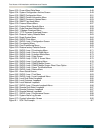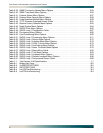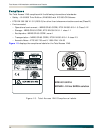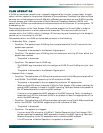
Total Access 1240 Installation and Maintenance Practice
2-2 61179605L5-5B
For security purposes, the unit operates such that Local Switching (Subscriber Port-to-Port
Switching) can be disabled/enabled within the unit. Port-to-Port switching can also be accom-
plished using an external device such as an Ethernet Aggregation Switch. Destination MAC
address filtering and Ether-type filtering are also implemented.
The Total Access 1240 supports RFC 2684 (RFC 1483) Bridged Protocol Data Unit (PDU) only.
All traffic priorities and queuing are accomplished in the ATM domain (subscriber side) and
later mapped into the Ethernet domain (network side).
The Total Access 1240 takes Ethernet packets and performs a Segmentation And Reassembly
(SAR) function into an RFC 1483 compliant scheme for transmission over the SHDSL loops to
permit broad compatibility with a wide variety of RFC1483 compliant SHDSL modems. The
unit uses four simplified Class of Service (COS) queues. Prioritization for the transmission of
packets is performed by assigning preference to highest priority packets first and moving to
lower priority packets until there is full bandwidth utilization on the subscriber ports.
The unit supports one to four VCs per port (per RFC1483) with one VLAN per VC. To utilize
four VLANs, the subscriber must have an RFC1483 capable modem that supports four VCs.
The Total Access 1240 supports the ITU G.991.2 SHDSL standard as well as the ETSI TS 101
542 (2001-08) standard. Data rates supported on the subscriber side are 192 kbps to 2.312
Mbps (1-pair) and 384 kbps to 4.624 Mbps (2-pair). Rate adaptive SHDSL Mode is planned for
a future software release.
Lineprobing (also known as rate adaption) is supported on a per port basis. This allows
automatic selection of the SHDSL loop rate based on line conditions at the time of the unit
training.
The maximum number of filtering entries that can be created in the system is 1,024. Conse-
quently, the capacity of the MAC table is 1,024 MAC addresses. The MAC Address table is
global per unit. The MAC addresses are learned on the uplink Ethernet port and the
subscriber loops.


















